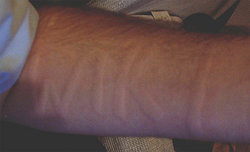NASHVILLE, TENN. -- Consider dermatographism as a possible cause of vulvovaginal pruritus, especially in severe, persistent cases that are unresponsive to antifungal drugs, Dr. Charity McConnell said in a poster presentation at the American Academy of Dermatology's Academy 2000.
"Our experience suggests a component of dermatographism ... and this physical urticaria may be the only etiology in some patients," said Dr. McConnell of the department of dermatology, Wake Forest University, Winston-Salem, N.C. She and her colleagues have found that some patients will respond well to oral antihistamines when all other types of medication have failed.
Antihistamines may, in fact, alleviate the need for extreme, last-resort surgical interventions such as vulvectomy, which some patients have accepted in an effort to quell their profound discomfort.
Dr. McConnell said the following symptom patterns point strongly toward dermatographism as a key etiologic component:
* Recurrence of symptoms or heightening of symptoms following vulvar stimulation or vaginal intercourse.
* Symptoms after friction or direct pressure to the vulvovaginal or perineal area from activities such as riding a bicycle.
* Worsening or triggering of symptoms after wearing tight clothing.
* Failure to respond to monotherapy with antifungal drugs or corticosteroids.
If the clinical profile is suggestive of dermatographism, it is a good idea to do a skin scratch test to see if the patient develops the characteristic urticarial response to the physical stimulus. However, Dr. McConnell cautioned that a negative scratch test on the patient's arm, trunk, or other anatomic site does not definitively rule out the possibility of vulvovaginal dermatographism. It is possible that the reaction is localized.
She presented three cases of severe, persistent, and unresponsive vulvovaginal pruritus and burning in women who turned out to have dermatographism on scratch testing. These patients had major symptom improvements when given a combination of oral cetirizine and doxepin.
The first case involved a 41-year-old woman who presented with a 3-year history of recurrent, cyclical vulvovaginal burning, stinging, and itching. She had been treated with fluconazole 100 mg weekly but had only partial symptom relief. The physical examination showed no vaginal discharge, fissuring, or excoriations. She had a positive response to thimerosal on patch testing, but this did not appear to play a role in the vulvar symptoms.
The patient was given a scratch test, and she proved to be highly dermatographic. Dr. McConnell started the patient on cetirizine 10 mg/day with adjunctive halcinonide ointment applied twice daily when symptoms were severe. The patient was instructed to reduce the fluconazole use to once monthly.
Seven days after beginning cetirizine, the patient reported some improvement but had a vaginal discharge. This was negative on potassium hydroxide testing for yeasts, but given her history, Dr. McConnell opted to hit hard with 3 consecutive days of fluconazole 100 mg followed by a monthly 100-mg dose after the patient's menstrual period. She also added nightly doxepin, beginning at 10 mg and increasing to 30 mg. At her next visit, 2 months later, the patient was dramatically improved.
The second case involved a 34-year-old woman who was referred for patch testing after a 3-year history of genital burning, itching, and swelling, particularly following sexual intercourse. The severity of the symptoms prompted the patient to have a partial vulvectomy, which largely eliminated the swelling but had little effect on the pain and pruritus. Monotherapy with amitriptyline, fluconazole, gabapentin, famciclovir, zolpidem, and cetirizine offered no relief.
The patient proved to be dermatographic on scratch testing, which prompted Dr. McConnell to try the cetirizine and doxepin combination. After several weeks on this combination, the patient remained dermatographic on scratch testing but reported a major improvement in the vulvovaginal symptoms.
The third patient was 35 years old and had a 6-month history of vulvovaginal burning and itching. Her primary care physician had prescribed an antifungal agent that helped somewhat but did not eliminate the symptoms, according to the patient. She was unable to tolerate vaginal penetration or wear pants, and she said the symptoms worsened after her menstrual period. The physical examination was essentially normal, although there was minimal erythema around the introitus.
This patient was not dermatographic on scratch testing, but the pattern of exacerbation following intercourse or wearing pants was highly suggestive of a physical urticaria. Dr. McConnell opted to try the combination of cetirizine 10 mg/day, doxepin 10-30 mg nightly, and halcinonide ointment applied as needed.
After 4 months of treatment, the patient reported that her symptoms had been nearly eliminated.
Dr. McConnell noted that there have been three previous case reports in the literature suggesting a link between physical urticaria and vulvovaginal itch. But she believes this patient's problem may be much more common than is currently realized.
"Antifungals against Candida may work to some degree if fungal infection is part of the process. But for many patients, there are residual symptoms." In these cases, an empirical trial of oral antihistamines is definitely worth a shot. Beyond sedation, there are no worrisome side effects, and the potential benefit in terms of symptom relief is great.
COPYRIGHT 2000 International Medical News Group
COPYRIGHT 2001 Gale Group



